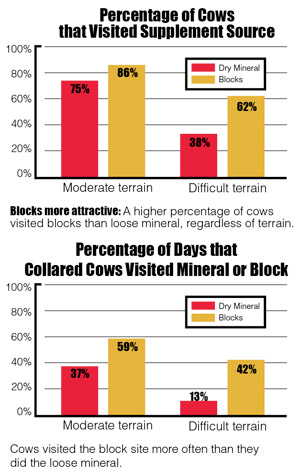
HAVRE, Montana —If CRYSTALYX® can attract cattle to better graze under-used pasture land, how does a loose dry mineral compare to CRYSTALYX®?
THE STUDY DETAILS
- Location: 630-acre and 820-acre pastures on the Thackeray Ranch in the Bear’s Paw Mountains, south of Havre. Each pasture’s terrain was classified as easy, moderate, difficult and extreme. Easy and extreme pastures were not used. Researchers based classification on nearness to water, elevation and slope.
- Grazing period: September through mid-November 2000 for pasture 1; late November through December 2000, for pasture 2.
- Setup: Electric fence split each pasture for two experimental treatments, allocating terrain styles equally. A total of 226 Continental-cross cow/calf pairs, previously acclimated to CRYSTALYX,® were randomly assigned to pastures and treatments. Cows in each group were randomly assigned to wear electronic Global Positioning Satellite (GPS) tracking collars that recorded their movement and grazing activity by satellite.
- Supplement: Experimenters offered cows either trace mineral-fortified 30 percent crude protein CRYSTALYX® BGF-30™, or a commercially prepared dry mineral mix in open mineral feeders. White salt blocks were also placed about 40 yards from each supplement source.
- Data collection: Investigators regularly collected data from the collars and observed cattle from horseback. They calculated the time cattle spent within 10, 100, 200, 400 and 600 yards of blocks, mineral and water. They then estimated the ability of each supplement to attract cattle into areas that were difficult to graze, and then hold them nearby.
RESULTS: IMPROVED GRAZING PATTERNS
- During the entire trial, 74 percent of the collared cows visited the CRYSTALYX® blocks at least once in four days. That compares to only 55 percent for the dry mineral mix.
- As expected, cattle were less likely to visit both supplement sources when they were placed on difficult terrain vs. moderate.
Cows sought out and visited the areas with CRYSTALYX® more often than those containing dry mineral. On average, cows visited the CRYSTALYX® blocks every other day. They visited dry mineral feeders only every four days. - CRYSTALYX® appeared to have the power to hold cows in under-utilized areas, thus increasing forage utilization. Cows actually spent about 400 percent more time at the CRYSTALYX® blocks than the dry mineral feeders.
- One of the biggest surprises in the fall and winter study was the finding that the CRYSTALYX® blocks were even more attractive than water. Cows spent more time within 200 to 600 yards of CRYSTALYX® blocks than within similar distances to water.
IMPLICATIONS
This study confirms previous studies showing that CRYSTALYX® can attract cattle to rougher portions of pasture land and improve grazing efficiency. It shows that blocks are visited more often and more consistently than loose mineral, offering a more effective supplement and grazing management tool than dry mineral.
SOURCE:
Bailey, DW. Effectiveness of Low-Moisture Molasses Blocks and Conventional Formulations for Delivering Supplemental Minerals to Cattle on Rangelands. Northern Agricultural Research Center, Montana State University, 2001.


